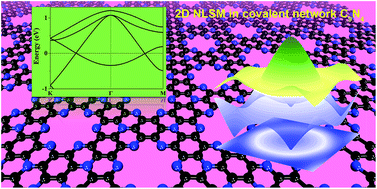Prediction of two-dimensional nodal-line semimetals in a carbon nitride covalent network†
Abstract
Carbon nitride covalent compounds have emerged as a prominent member of 2D materials beyond graphene. The experimental realizations of 2D graphitic carbon nitride g-C3N4, nitrogenated holey graphene C2N, and polyaniline C3N have shown their promising potential in energy and environmental applications. In this work, we predict a new type of carbon nitride network with a C9N4 stoichiometry from first principles calculations. Unlike common C–N compounds and covalent organic frameworks (COFs), which are typically insulating, surprisingly C9N4 is found to be a 2D nodal-line semimetal. The nodal line in C9N4 forms a closed ring centered at the Γ point, which originates from the pz orbitals of both C and N. The linear crossing occurs right at the Fermi level contributed by two sets of dispersive Kagome and Dirac bands, which is robust due to negligible spin–orbit coupling in C and N. Furthermore, it is revealed that the degeneracy along the high-symmetry path is protected by out-of-plane mirror or C2 rotational symmetry, rather than in-plane mirror symmetry. The chemical potential difference between C and N, as validated by using a single orbital tight-binding model, plays a significant role in forming the nodal ring. Interestingly, a new structure of the nodal line, i.e., a nodal cylinder, is found in momentum space for AA-stacked C9N4. Our results indicate possible functionalization for a novel metal-free C–N covalent network with interesting semimetallic properties.



 Please wait while we load your content...
Please wait while we load your content...
